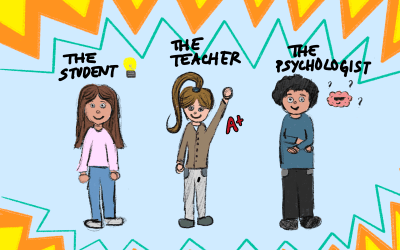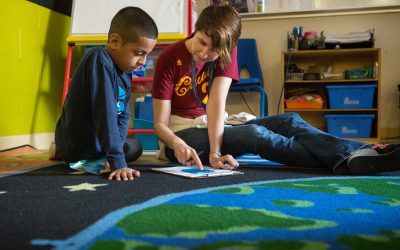
Though often described interchangeably, competencies and standards are in some ways worlds apart.
If you’re asking this question, then well done, you! This question is a bridge from the old world order (of formal schooling) to the new. It can unlock some important insights for practitioners seeking to make to the journey to competency-based teaching and learning.
Let’s get right to it. We at reDesign have taken a pass at summarizing the key distinctions between competencies and standards, and the movements behind them. For now, we are describing these differences along six key dimensions:
1. Context and Purpose
2. Grain Size
3. Focus
4. Gradation Progressions and PLDs)
5. Implications for Assessment
6. Mastery, Grading, and Promotion
1. Context and Purpose
The original intent behind the early work of developing academic standards was fundamentally to help improve the quality of teaching. Lauren Resnick, one of the early movers and shakers of this effort, helped lead the way in creating performance standards in the early 1990s to clarify instructional goals and expectations. However, the decade that followed brought with it a sharp policy shift toward testing and accountability that has in many ways diminished standards-based instruction to a means of measuring content coverage and test readiness.
Lauren Resnick led the The New Standards Project from 1990-1999 to improve student performance through the development of performance-based standards and assessments that greatly influenced state and district policy. By the early 2000s, every state had adopted a set of standards (Hamilton et al, 2008).
While this has had devastating consequences for learning, there is a silver lining. From a systems perspective, academic standards enable states and districts to monitor and compare school outcomes and identify inequities in the system. This is important, because prior to No Child Left Behind, there was no way to disaggregate comparative data and determine whether students across different demographic groups were being served equitably. If there had ever been a doubt, there is no doubt now.
Quite differently, competency-based models reach back centuries, with early apprenticeship learning that created pathways for mastery and gainful employment. Think: Medieval craft guilds, masonry, baking, carpentry, shoemaking.
The notion of “competency” in formal education is derived from the philosophical and pedagogical ideas of such thought leaders as John Dewey and Benjamin Bloom, who emphasized that all learning should be meaningful and relevant, and that young people at any level can be successful and achieve at high levels with the right supports and learning experiences.
In contemporary times, competencies are being developed from a much more aspirational and contextualized place than that of academic standards. School communities, districts, and states are creating competencies that encompass the knowledge, skills, and dispositions needed for purposeful, meaningful, and productive life in the world beyond school. Competencies often extend beyond academics into such domains of life as wellness, personal efficacy, and even spirituality. In this way, competencies are helping communities define a well-rounded vision for learners, balancing measurability with mission-alignment, and personalization with a commitment to readiness for college, career, and lifelong learning. Interestingly, many competency sets that we’ve seen in the field are being crafted with student-facing language. This is very much in contrast to academic standards that are typically written for teacher use (and many, we would argue, are not actually written in a very teacher-friendly or pedagogically helpful way).
Two “take-home” considerations:
We would be remiss without mentioning one of the possible challenges around the bend for the competency-based movement. As competency-based education gains ground in formal K-12 schooling, there is a very real chance that the movement could lose the “spirit” of its intent and become yet another, albeit more refined, form of standards-basedlearning.
My partner at reDesign, Antonia Rudenstine, has put it quite candidly: standardized learning is the hallmark of the industrialized education model of the 19th century. If the principles of competency-based education are unable to reshape the system itself- time and scheduling, grading systems, promotion and crediting policies, credentialing and human capital strategies, and most importantly, a deficit orientation toward children and learners– it is likely that students will continue to be sorted by, and shuffled through, an education system that is designed for efficiency, not equity. We are beginning to see this in online adaptive curriculum that provides a standardized, “personalized” program for students. Here’s the rub: although the program might meet them where they are academically, ultimately, they are all going to the same place, and all using the online program to get there. We need competencies to define a more holistic vision for learners that reflects the individual, and we need a transformed system to delivering on its promise.
This takes us to a second take-home point, one that has been eloquently stated by Chris Sturgis of CompetencyWorks: perhaps the most important difference of all between standards-based learning and competency-based learning is the commitment to the student. In standards-based systems, standards set a consistent target for teaching but in practice, there is no specific commitment that all students achieve the target. Students may be promoted to higher levels whether demonstrably proficient or not, and traditional grades serve as the marker of student performance relative to the standards. In other words, the system remains unchanged, although the quality of instruction may be enhanced.
In competency-based models, the entire system must change. Students advance upon mastery when they are ready, not when an arbitrary academic calendar suggests that they should be. Most importantly, students receive the timely, differentiated supports they need in order to experience success and advance to the next level. Optimally, competencies are broad enough that student pathways and demonstrations of proficiency can be vastly different, organized to encourage and nurture student passions and questions. Failure is no longer an acceptable label for children or feature of the system: if a student isn’t proficient at a particular moment, then more learning and practice opportunities will be encouraged and facilitated. When proficiency is reached, the student will move on. The school bends to the child’s learning needs, not the other way around.
#2 Grain Size
Competencies sit above standards in terms of grain size. They are organized around specific learning outcomes that have meaning and importance in the world. For example, a competency might be defined as the ability to communicate with clarity and purpose, construct an evidence-based argument, or collaborate with others. In this sense, competencies tend to encompass an interrelated set of skills, knowledge, aptitudes, and/or capacities. In practice, competencies are often constructed as groupings of related skills or attributes that are purposefully designed to be explicit, measurable, transferable, and empowering to students (Sturgis, 2016). Well-designed competencies have a consistent grain size among all skills or measures, and each skill or measure may encompass multiple learning standards.
Quite differently, academic standards are often written as discrete statements of what students will know or be able to do, and are typically organized by subject area, course and grade level. They are not always grouped and attached to meaningful, transferable outcomes, and often the same standard set may have standards that are written at very different levels of granularity, such that one standard might define a single, discrete learning objective, where another standard within the same set might encompass many learning objectives.
Let’s take a look at an example. We’ll take a look at few high school Physics standards published by the California Department of Education.
|
Electric and Magnetic Phenomena 5i. Students know plasmas, the fourth state of matter, contain ions or free electrons or both and conduct electricity. 5o. Students know how to apply the concepts of electrical and gravitational potential energy to solve problems involving conservation of energy. You’ll notice that the first standard displayed above (5i) states that students should be able to recall factual information about plasmas. A few rows down, a different standard (5o) states that students need to know how to apply their knowledge of multiple scientific concepts (electrical energy, gravitational energy, potential energy) to solve “problems involving conservation of energy.” Quite different in terms of grain size, and drastically different in terms of level of understanding on Bloom’s Taxonomy. You’ll also notice the first standard emphasizes knowledge, whereas the second standard emphasizes skills and concepts. This takes us to our next point about focus.
|
#3 Focus
The focus of learning standards has historically been content knowledge (e.g., the water cycle; the War of 1812; plasmas conduct electricity), although more recently developed standard sets have in some cases exclusively emphasized skills, such as Common Core Learning Standards.
Competencies, on the other hand, tend to emphasize the application of skills, knowledge and dispositions rather than content knowledge. Competency-based models approach content as the backdrop, while putting essential skills and dispositions front and center. In this way, content serves as the context for practicing and demonstrating “transferable” competencies that can be applied in different contexts. Take, for instance, the ability to persuade an audience: whether you’re in a classroom, a courtroom, or a congressional hall, many of the underlying knowledge, skills, and dispositions are the same.
Why this lack of emphasis on content knowledge? While content knowledge is certainly important for particular career pathways and its value as social currency, it’s a bit of a moving target, and a biased one at that. Who decides which content knowledge is important, for example, in a US history course? And how can we know what content knowledge will be important and relevant in 20 years from now?
This is yet another point in the case for personalized education in which learning pathways reflect the interests and goals of the individual, and in which less and less precious instructional time is spent on information that is ever-changing, more accessible than ever because of technology, and of varying levels of relevance and importance to people’s lives.
On the topic of focus: Let’s take a look at this set of Pennsylvania state history standards for grade 6, 9, and 12. What do you notice?
Here’s a quick snapshot of what we see:
- The standards are written in a way that combines skills (e.g., identify, explain, analyze, evaluate), knowledge (e.g., Margaret Brent’s vote, impeachment of Andrew Jackson), and concepts (e.g., continuity and change).
- The standards attach specific content and skills to grade levels. Notice how “analyze” is designated for ninth grade and “evaluate” is designated for twelfth grade. We think this is problematic, and conflicts with one of the key principles behind Bloom’s Taxonomy: all students, no matter their age, can reach high levels of learning. In other words, sixth grade students should be expected to analyze, not only explain. Ninth grade students should be expected to evaluate, not only analyze.
- The skills and conceptual understandings embedded in this standard meet our criteria for “transferable.” Specifically, analyzing and evaluating are important thinking skills that apply in any domain. The notion of continuity and change is an important concept as well, that also applies to multiple domains (not only history). What’s unhelpful about the way in which these standards are written is that they do not provide any guidance to the learner (or the teacher!) about what these skills and conceptual understandings look like at each performance level. In fact, apart from the content list associated with each level, only the verb itself is different (i.e., explain, analyze, evaluate). One could argue that it is assumed that the teacher knows what differentiates these levels of understanding. This is fair enough, but it does mean that these standards are not useful to students, as they do not make clear how one would develop and demonstrate these skills and conceptual understandings on a path to mastery.
- A note on content: Who gets to decide who and what historical figures make this list? As educators, we know it’s important to bring a critical perspective to our work, and to challenge the assumptions about whose voices, perspectives, and histories get included or not, how, and why. It was only last year that a textbook publisher described the African Slave Trade as “workers” who were part of a “pattern of migration” to the southern United States. This is stunning, painful, and wrong.
- How does this connect for students to a meaningful and important outcome? Does this set of skills, knowledge, and concepts have a purpose beyond the four walls of school? If they achieve these standards, for example, how is that useful or important in their lives or futures? That’s not to say that it isn’t, only that it should be (and should be obvious to kids).
#4 Gradation (Progressions and PLDS)
Competencies define skills that are practiced and developed continuously. They are not “one and done,” like many standards, which are course-based and attached to specific grade levels or bands.
In competency-based models, performance level descriptors (PLDs) clarify the developmental journey from novice-to-expert or to “mastery.” As such, PLDs help students understand, in explicit and transparent terms, where they stand and what they need to do to advance to higher levels. Importantly, in truly competency-based systems, PLDs are not attached to specific grade levels, as we know that learning happens in different ways and at different times for children, and not in an even sequence along linear progressions based on age.
This is an important point to emphasize: we believe strongly that we must guard against tying PLDs to age-based grades or cohorts. An eleven year-old can be a virtuoso violinist, and most eighteen year-olds are likely to never be. PLDs are guideposts to mastery, they are not research-based progressions that define the developmentally appropriate age in which various skills and concepts should be mastered. If we are truly seeking to personalize learning, we must recognize there are aspects of the learning process that simply cannot be standardized. If we tie our competency PLDs to grade levels, we are falling back into the standardizing movement.
#5 Implications for Assessment
The design of competencies and standards has significant implications for assessment types and quantities. Specifically, the design of the learning outcome (whether standard or competency) dictates how learning will be measured. If the learning outcome is content-focused, as many standard sets are, the assessment is likely to be reduced to lower level questions that involve recall and comprehension. When learning outcomes are defined in terms of the application of skills or the synthesis and creation of new knowledge, we’re then talking about a much more sophisticated assessment type. This is what is distinctive about the implication of competencies for assessment systems. Just as in the world, competence is about successful application of skills and knowledge to achieve a particular purpose, not simply to show basic levels of understanding. It is also assumed that you can successfully apply your skills multiple times, in multiple contexts. Would you board a plane with a pilot who can only land a plane if there is a tailwind, or safely landed only 65% of the time?
#5 Implications for Assessment
The design of competencies and standards has significant implications for assessment types and quantities. Specifically, the design of the learning outcome (whether standard or competency) dictates how learning will be measured. If the learning outcome is content-focused, as many standard sets are, the assessment is likely to be reduced to lower level questions that involve recall and comprehension. When learning outcomes are defined in terms of the application of skills or the synthesis and creation of new knowledge, we’re then talking about a much more sophisticated assessment type. This is what is distinctive about the implication of competencies for assessment systems. Just as in the world, competence is about successful application of skills and knowledge to achieve a particular purpose, not simply to show basic levels of understanding. It is also assumed that you can successfully apply your skills multiple times, in multiple contexts. Would you board a plane with a pilot who can only land a plane if there is a tailwind, or safely landed only 65% of the time?
Join the community!
Sign up to receive our newsletter, access best-of educational resources, and stay in the know on upcoming events and learning opportunities. We hope to see you soon!



